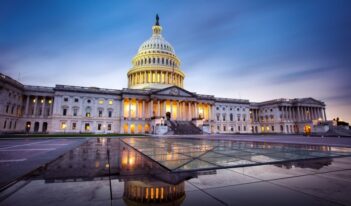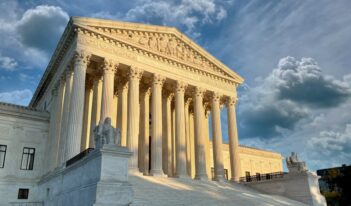
The Supreme Court overturns the Chevron Doctrine, rules that Presidents are immune from prosecution for official actions, and more…
IN THE NEWS
- The U.S. Supreme Court overturned a 40-year-old decision in Chevron v. Natural Resources Defense Council, which instructed federal judges to defer to administrative agencies for interpreting ambiguous laws passed by Congress. Chevron often applied when an agency had a legal dispute with an individual, business, or state government. Writing for the majority in a 6-3 decision in Loper Bright Enterprises v. Raimondo, Chief Justice John G. Roberts said “courts must exercise their independent judgment in deciding whether an agency has acted within its statutory authority.” Chief Justice Roberts’s opinion for the Court stated that previous decisions relying upon Chevron are still lawful and challenging them will require a “special justification.” Justice Elena Kagan, however, argued in a dissent that courts “can always come up with something to label a ‘special justification.’” Some legal experts argue the decision will hamper agencies’ effectiveness, including in regulating the environment, public health, and workplace safety.
- The U.S. Supreme Court ruled that U.S. Presidents are entitled to immunity from federal prosecution for official actions taken while in office. The 6-3 decision throws out a ruling by U.S. Court of Appeals for the District of Columbia against former President Donald Trump. The criminal charges relating to the former President’s alleged attempt to retain power after the 2020 election are remanded to the federal trial court to be decided with the Supreme Court’s new guidance applied. Justice Sotomayer wrote a scathing dissent, stating that the President is “a king above the law.” While former President Trump celebrated the decision as a “big win for our constitution and democracy,” President Biden strongly condemned the decision as undermining “long-established legal principles.”
- The U.S. Supreme Court ruled that bans on sleeping outdoors do not violate the Eighth Amendment of the U.S. Constitution. In a 6-3 decision, the Court rejected the petitioners’ claim that criminalizing sleeping outdoors is equivalent to criminalizing someone based on their status, which was barred under the Eighth Amendment by the 1962 decision Robinson v. California. Justice Neil Gorsuch wrote that such ordinances do not criminalize one’s status as homeless because “it makes no difference whether the charged defendant is homeless, a backpacker on vacation passing through town, or a student who abandons his dorm room to camp out in protest.” In her dissent, Justice Sonia Sotomayor, joined by Justices Elena Kagan and Ketanji Brown-Jackson, argued that sleeping outside is some people’s only option, and using jails or fines is “cruel and unusual” punishment for being homeless.
- The U.S. Supreme Court ruled that the six-year statute of limitations on claims brought under the Administrative Procedure Act (APA) begins when “the plaintiff is injured by final agency action,” not when the agency action becomes final. With the decision, the Court reinstated a North Dakota convenience store’s challenge to a Board of Governors of the Federal Reserve System rule on debit card swipe fees, reversing lower court rulings that dismissed the claim as time-barred. The Court’s broader interpretation of the statute of limitations under the APA may increase the amount of challenges to federal regulations in the future.
- The U.S. Supreme Court has dismissed Moyle v. United States, a case that would have answered the question of whether emergency room doctors in Idaho can perform abortions as health stabilizing measures. The divided decision to dismiss the case hinged on Justice Barrett’s concurrence, joined by Chief Justice Roberts and Justice Kavanaugh, that emphasized that a true conflict of law was difficult to find, due to multiple changes in a federal law since litigation began. The Emergency Medical Treatment and Active Labor Act (EMTALA) commands that hospitals receiving Medicare funding must provide emergency care, including abortions, which is in line with Idaho’s life-of-the-mother exception to its strict abortion laws. There was a previously perceived conflict between the language of the federal law that specified mental health concerns as a viable reason to administer an emergency abortion, but that language has since been amended so the Idaho and federal requirements seem to now align.
- The U.S. Supreme Court rejected a case challenging the authority of the Occupational Safety and Health Administration (OSHA) to regulate workplace safety. The plaintiff, an Ohio contractor, argued that OSHA’s broad regulatory powers violated the constitutional principle of separation of powers. By refusing to hear the case, the Court left in place lower court rulings that uphold OSHA’s authority to enforce safety regulations aimed at protecting workers.
- The U.S. Supreme Court ruled that an obstruction statute previously used to prosecute January 6th rioters is narrower than previously understood. The Court decided, using a primarily textualist analysis, that relying on the word “otherwise” in the statute to prosecute rioters was incorrect. The majority emphasized that listed means of obstruction, such as destroying or altering documents, were to be taken as a complete set of potential charges and not as examples within a more general application. This decision will make prosecuting some January 6th rioters under this statute more difficult, but Attorney General Merrick Garland noted that this narrowment will not impact the “vast majority” of January 6th cases.
- The Internal Revenue Service (IRS) and the U.S. Department of Treasury finalized new regulations on reporting requirements for digital asset brokers, such as those maintaining cryptocurrency platforms. Starting in 2026, brokers will have to report gross proceeds on digital asset sales. By 2027, they must also provide details on the tax basis for particular digital assets. The Treasury stated that although digit asset owners have always owed taxes on their sales, the new regulations will ensure that owners “receive the information they need from brokers to file their taxes more accurately, more easily, and less expensively.”
WHAT WE’RE READING THIS WEEK
- In a recent National Bureau of Economic Research working paper, Ronan C. Lyons, an associate professor of economics at Trinity College Dublin, and several coauthors created “the first consistent market rent and home sales price series” in 30 American cities from 1890 to 2006, identifying several unknown facts about housing markets during this period. The data series includes “rental prices, sales prices, capital gains, rental returns, total housing returns, and rent-to-price ratios for cities and the U.S. as a whole,” alongside an alternative consumer price index using Historical Housing Prices Project data. The Lyons team found that real housing sale prices grew more from 1965 to 1995 than was formerly understood. Lyons and his coauthors also noted that real rental price levels rose by approximately 20 percent during this time period. The Lyons team suggested that increases in housing prices were uneven across cities partly due to variation in regulatory constraints, such as the use of restrictive zoning policies.
- In an article in the Yale Law Journal, Alison Gocke, an associate professor of law at the University of Virginia, argued that state public utility commissions have significant, yet often overlooked, potential to ameliorate the effects of climate change by bridging the “traditional divide” between energy and environmental regulations. Gocke examined New York City’s mid-20th century transition from coal to natural gas, coordinated by New York’s Public Service Commission, to illustrate how public utility regulation can achieve environmental goals. She concluded that the reluctance of modern commissions to engage in a clean-energy transition stems from “structural and political dynamics,” rather than legal limitations.
- In a recent essay in the Duke Law & Technology Journal, Maura R. Grossman, a Research Professor in the School of Computer Science at the University of Waterloo and an adjunct Professor at Osgoode Hall Law School, with coauthors, Paul W. Grimm, Daniel G. Brown, and Molly (Yiming) Xu, discussed the implications of generative AI on legal proceedings. The authors emphasized that the rapid development of AI and its current and expected level of ability could both cause lawsuits and necessitate new procedures. Potential new rules of evidence, expert costs, and substantive law changes are possible, according to the authors, as courts try to adapt to AI impacts in the courtroom. The authors emphasized that AI can have both positive and negative implications for the courtroom. They speculated that if AI proliferates in the legal market, more clients will be able to file competent pleadings and justice may be advanced more easily, but AI also may eventually overtake the role of judges entirely.
EDITOR’S CHOICE
- In an essay in The Regulatory Review, Cary Coglianese, the Edward B. Shils Professor of Law and Director of the Penn Program on Regulation at the University of Pennsylvania, examined the potential reasons behind the decline of the Chevron doctrine. He argued that “Chevron Step Zero,” a preliminary step used to determine if the Chevron framework itself would apply, might have inadvertently weakened the doctrine by fostering perceptions of judicial passivity and an assumption that judicial deference to the agency’s interpretation of a statute was automatically supposed to follow from a court’s finding of statutory ambiguity. Coglianese concluded that the legal scholars and practitioners who accepted the terminology of a “Step Zero” that preceded Chevron’s now invalidated two steps may have unintentionally contributed to the doctrine’s downfall.



